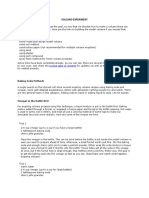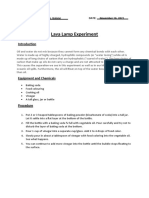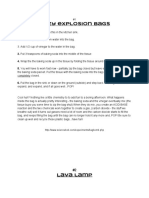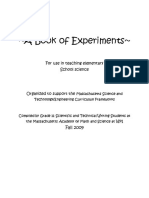Lava Lamp 4
Lava Lamp 4
Uploaded by
Nurshida AyuCopyright:
Available Formats
Lava Lamp 4
Lava Lamp 4
Uploaded by
Nurshida AyuOriginal Description:
Original Title
Copyright
Available Formats
Share this document
Did you find this document useful?
Is this content inappropriate?
Copyright:
Available Formats
Lava Lamp 4
Lava Lamp 4
Uploaded by
Nurshida AyuCopyright:
Available Formats
http://www.sciencebob.com/experiments/lavalamp.
php
A clean 1 liter clear soda bottle 3/4 cup of water Vegetable Oil Fizzing tablets (such as Alka Seltzer) Food coloring
1. Pour the water into the bottle. 2. Use a measuring cup or funnel to slowly pour the vegetable oil into the bottle until it's almost full. You may have to wait a few minutes for the oil and water separate. 3. Add 10 drops of food coloring to the bottle (we like red, but any color will look great.) The drops will pass through the oil and then mix with the water below. 4. Break a seltzer tablet in half and drop the half tablet into the bottle. Watch it sink to the bottom and let the blobby greatness begin! 5. To keep the effect going, just add another tablet piece. For a true lava lamp effect, shine a flashlight through the bottom of the bottle.
To begin, the oil stays above the water because the oil is lighter than the water or, more specifically, less dense than water. The oil and water do not mix because of something called "intermolecular polarity." That term is fun to bring up in dinner conversation. Molecular polarity basically means that water molecules are attracted to other water molecules. They get along fine, and can loosely bond together (drops.) This is similar to magnets that are attracted to each other. Oil molecules are attracted to other oil molecules, they get along fine as well. But the structures of the two molecules do not allow them to bond together. Of course, theres a lot more fancy scientific language to describe density and molecular polarity, but maybe now youll at least look at that vinegrette salad dessing in a whole new way.
http://www.sciencebob.com/experiments/lavalamp.php When you added the tablet piece, it sank to the bottom and started dissolving and creating a gas. As the gas bubbles rose, they took some of the colored water with them. When the blob of water reached the top, the gas escaped and down went the water. Cool, huh? By the way, you can store your "Blobs In A Bottle" with the cap on, and then anytime you want to bring it back to life, just add another tablet piece.
The project above is a DEMONSTRATION. To make it a true experiment, you can try to answer these questions: 1. Does the temperature of the water affect the reaction? 2. Does the size of the bottle affect how many blobs are produced? 3. Does the effect still work if the cap is put on the bottle? 4. Does the size of the tablet pieces affect the number of blobs created?
You might also like
- Laidler Physical Chemistry 4th EditionDocument1,078 pagesLaidler Physical Chemistry 4th EditionqamaralmahseriNo ratings yet
- Lava Lamp ExperimentDocument7 pagesLava Lamp ExperimentLyan EmmyNo ratings yet
- Logicpress Set: Made in ItalyDocument2 pagesLogicpress Set: Made in ItalyMohammad ZeeshanNo ratings yet
- Watercut Monitor Operation and Calibration Guide: Model Series DC-1510 & DC-3510Document23 pagesWatercut Monitor Operation and Calibration Guide: Model Series DC-1510 & DC-3510DIEGO GIOVANNY MURILLO RODRIGUEZ100% (1)
- CHME 7320 (CRN 11012 - 15531) FALL 2017 FINAL (2) - MS Word - 9-5-2017Document53 pagesCHME 7320 (CRN 11012 - 15531) FALL 2017 FINAL (2) - MS Word - 9-5-2017Dev Rana0% (1)
- 9a Alkaseltzer Rates of ReactionDocument13 pages9a Alkaseltzer Rates of Reactionapi-298247873100% (1)
- How To Make A Simple Lava LampDocument4 pagesHow To Make A Simple Lava LampakosiprixNo ratings yet
- Blobs BottleDocument3 pagesBlobs BottleTara Anne YuNo ratings yet
- Density The Amazing Water Trick MaterialsDocument8 pagesDensity The Amazing Water Trick MaterialsTwinkleAnneGonzalesRosalesNo ratings yet
- Blobs in A BottleDocument1 pageBlobs in A BottleJasper Panal ParenaNo ratings yet
- Lava LampDocument3 pagesLava LampTeacher EdnaNo ratings yet
- The Lava LampDocument5 pagesThe Lava LampMathew DegamoNo ratings yet
- Volcano ExperimentDocument5 pagesVolcano ExperimentjomerNo ratings yet
- Science ExperimentsDocument23 pagesScience ExperimentsComeTogetherKids100% (1)
- Sains ExperimentDocument6 pagesSains ExperimentMuhammad KhairiNo ratings yet
- Lava LampDocument2 pagesLava LampHema Jothy0% (2)
- Lava LampDocument2 pagesLava LampJulia Geonzon LabajoNo ratings yet
- Scientific Experiments for Kids! Chemistry for Kids Series - Children's Analytic Chemistry BooksFrom EverandScientific Experiments for Kids! Chemistry for Kids Series - Children's Analytic Chemistry BooksNo ratings yet
- Lava Lamp Experiment: NAME: Trisha Joanne S. Galang DATE: November 16, 2021Document2 pagesLava Lamp Experiment: NAME: Trisha Joanne S. Galang DATE: November 16, 2021Cyrus De LeonNo ratings yet
- Make A Big Dry Ice Bubble: What You'll NeedDocument9 pagesMake A Big Dry Ice Bubble: What You'll Needฮันนี่ คริสNo ratings yet
- Things NeededDocument13 pagesThings NeededInthara ArthiNo ratings yet
- How To Make Lamp Lava: Tool and MaterialDocument1 pageHow To Make Lamp Lava: Tool and Materialkarlita_pamelaNo ratings yet
- Enjoy Our Range of Fun Science Experiments For Kids That Feature Awesome HandsDocument4 pagesEnjoy Our Range of Fun Science Experiments For Kids That Feature Awesome HandsRosa ElenaNo ratings yet
- The Best Homemade Lava LampDocument7 pagesThe Best Homemade Lava LampJelena MitrovicNo ratings yet
- Oil and Water: What You'll NeedDocument2 pagesOil and Water: What You'll NeedMelisa MelsNo ratings yet
- Fizzy Explosion BagsDocument18 pagesFizzy Explosion BagsSyamira MddahinNo ratings yet
- Lava LampDocument4 pagesLava LampEdward LactamNo ratings yet
- Lava LampDocument2 pagesLava LampRoland Garcia Pelagio Jr.No ratings yet
- Aira Science ProjectDocument30 pagesAira Science ProjectAlvin TorioNo ratings yet
- Fizzy EyeDocument10 pagesFizzy EyeEko Sulistiyaning WarniNo ratings yet
- ExperimentDocument4 pagesExperimentsasic9697No ratings yet
- Eks 1Document6 pagesEks 1Medline TahaNo ratings yet
- Lava Lamp LabDocument6 pagesLava Lamp Labapi-302399796No ratings yet
- Scienceactivities1 PDFDocument98 pagesScienceactivities1 PDFbbaalluuNo ratings yet
- Lava Lamp 2Document3 pagesLava Lamp 2Nurshida AyuNo ratings yet
- Magnetic Pick Up: You Will NeedDocument6 pagesMagnetic Pick Up: You Will NeedLilian Laurel CariquitanNo ratings yet
- Gen Chem PTDocument4 pagesGen Chem PTJR RencioNo ratings yet
- Investigatory Project SampleDocument6 pagesInvestigatory Project SampleMarian OclinariaNo ratings yet
- Science IV 2011-2012Document9 pagesScience IV 2011-2012Marc SealzaNo ratings yet
- Laboratory ExperimentDocument5 pagesLaboratory ExperimentKoji OdoNo ratings yet
- Confounding Color: What You NeedDocument9 pagesConfounding Color: What You NeedAnonymous hb3Dvgc7No ratings yet
- Water Labs FullDocument4 pagesWater Labs FulljohnosborneNo ratings yet
- ISCI 172 Chemistry and Physics Lesson Plan SheetDocument3 pagesISCI 172 Chemistry and Physics Lesson Plan Sheetapi-426890939No ratings yet
- Self Inflating Balloon Experiment: Learning ActivitiesDocument10 pagesSelf Inflating Balloon Experiment: Learning Activitieshazron pandianganNo ratings yet
- DIY Lava LampDocument5 pagesDIY Lava LampsyahidNo ratings yet
- Seai Chemical Energy PDFDocument5 pagesSeai Chemical Energy PDFUltraman TaroNo ratings yet
- Chemistry I.PDocument14 pagesChemistry I.PCharles Ayer MercadoNo ratings yet
- Science ActivitiesDocument18 pagesScience Activitiesapi-503628320100% (1)
- Lava LampDocument8 pagesLava LampPhatcharakan ChoungsomNo ratings yet
- Make An Easy Lava LampDocument2 pagesMake An Easy Lava LampAnisaNuraidaNo ratings yet
- Make An Easy Lava Lamp: What You'll NeedDocument2 pagesMake An Easy Lava Lamp: What You'll NeedAnisaNuraidaNo ratings yet
- CHE1400 - Lab5 DescriptionDocument2 pagesCHE1400 - Lab5 Descriptionibtihalboujeddaine176No ratings yet
- Chemistry ScriptDocument16 pagesChemistry ScriptJim Boy BumalinNo ratings yet
- LAB 2-CHM01aLDocument5 pagesLAB 2-CHM01aLNova Jane EdradNo ratings yet
- Catch A RainbowDocument6 pagesCatch A Rainbowbech1No ratings yet
- Science ProjectDocument10 pagesScience Projectmusic pleaseNo ratings yet
- 2011 EverydayScienceAnswersDocument6 pages2011 EverydayScienceAnswersRajiv KumarNo ratings yet
- Supersaturated SolutionsDocument3 pagesSupersaturated Solutionsjennylee00182No ratings yet
- Ajlin Lica Make A Lava LampDocument3 pagesAjlin Lica Make A Lava LampMirjeta ZymeriNo ratings yet
- MethDocument2 pagesMethbindersoft2No ratings yet
- The Lovely Lava Lamp Lab Background: NameDocument3 pagesThe Lovely Lava Lamp Lab Background: NameChristinaNo ratings yet
- New Text DocumentDocument24 pagesNew Text Documentphatscat100% (1)
- Self Inflating Balloon: Plastic Chemistry - Making SlimeDocument4 pagesSelf Inflating Balloon: Plastic Chemistry - Making SlimeJohn Christian MacanNo ratings yet
- Enrichment WorksheetDocument1 pageEnrichment WorksheetNurshida AyuNo ratings yet
- LESSON PLAN Listening and SpeakingDocument11 pagesLESSON PLAN Listening and SpeakingNurshida Ayu88% (17)
- Rubric For Language ArtsDocument1 pageRubric For Language ArtsNurshida AyuNo ratings yet
- Crazy Putty: What You'll NeedDocument1 pageCrazy Putty: What You'll NeedNurshida AyuNo ratings yet
- Lava Lamp 2Document3 pagesLava Lamp 2Nurshida AyuNo ratings yet
- Format of Lesson PlanDocument9 pagesFormat of Lesson PlanNurshida Ayu0% (1)
- Jadual KerjaDocument1 pageJadual KerjaNurshida AyuNo ratings yet
- Jadual Waktu Praktikum Fasa Ii (Sains & PJ)Document1 pageJadual Waktu Praktikum Fasa Ii (Sains & PJ)Nurshida AyuNo ratings yet
- Ajk Trip ZooDocument1 pageAjk Trip ZooNurshida AyuNo ratings yet
- Learner Teacher:: Learner Has A Need To Know, Therefore, Defines Questions, Issues orDocument3 pagesLearner Teacher:: Learner Has A Need To Know, Therefore, Defines Questions, Issues orNurshida AyuNo ratings yet
- 1 - Petrobras - DeepWater Gas LiftDocument36 pages1 - Petrobras - DeepWater Gas LiftNisar KhanNo ratings yet
- Themathematicsofthebose Gasanditscondensation: Elliott H. Lieb, Robert Seiringer, Jan Philip Solovej and Jakob YngvasonDocument217 pagesThemathematicsofthebose Gasanditscondensation: Elliott H. Lieb, Robert Seiringer, Jan Philip Solovej and Jakob YngvasonTomasevic BojanaNo ratings yet
- 01 - Bavaria CO2 FiresearchDocument3 pages01 - Bavaria CO2 FiresearchDaryl Gomez Timatim100% (1)
- How Much Gas Is ProducedDocument8 pagesHow Much Gas Is ProducedDemba MarongNo ratings yet
- wm308 Wellmate Catalog Rev D Je15Document12 pageswm308 Wellmate Catalog Rev D Je15Juan GutierrezNo ratings yet
- Demulsification &desalinationDocument59 pagesDemulsification &desalinationnilay05No ratings yet
- Haynes - Curme - 1923 - Production of EthyleneDocument6 pagesHaynes - Curme - 1923 - Production of EthyleneEdwinAndresRodriguezNo ratings yet
- ALFAsim Technical Manual EN USDocument70 pagesALFAsim Technical Manual EN UScleuberNo ratings yet
- Aqa Chem1 QP Jan13 PDFDocument16 pagesAqa Chem1 QP Jan13 PDFMazlinNo ratings yet
- Chemistery P3 MergedDocument161 pagesChemistery P3 MergedMoh MohyNo ratings yet
- DehydrationDocument13 pagesDehydrationSaa D ShamimNo ratings yet
- Neet Ug Leader Detailed SyllabusDocument12 pagesNeet Ug Leader Detailed SyllabusSaniya KhanNo ratings yet
- Chamber Furnaces - High Temperature (HTC)Document16 pagesChamber Furnaces - High Temperature (HTC)Pembela KebenaranNo ratings yet
- Manometer Measuring TanksDocument4 pagesManometer Measuring TanksBouncer Bin100% (1)
- REVIEWERDocument8 pagesREVIEWERLiezl De JesusNo ratings yet
- Neet Question Paper 2019 Code r3Document27 pagesNeet Question Paper 2019 Code r3Deev SoniNo ratings yet
- Widiastuti Et Al 2022 Annealing and Tmos Coating On PSF ZTC Mixed Matrix Membrane For Enhanced Co2 ch4 and h2 ch4Document19 pagesWidiastuti Et Al 2022 Annealing and Tmos Coating On PSF ZTC Mixed Matrix Membrane For Enhanced Co2 ch4 and h2 ch4Alvin Rahmad WidyantoNo ratings yet
- Daily Lesson Plan in Physical EducationDocument15 pagesDaily Lesson Plan in Physical EducationKler DaradarNo ratings yet
- ESP Precipitator Flow DiagramDocument1 pageESP Precipitator Flow DiagramMohammed HamoodNo ratings yet
- Learning Plan For Peacscience8sepDocument5 pagesLearning Plan For Peacscience8sepMaam Elle CruzNo ratings yet
- PIPE Reviewer LooksfamDocument15 pagesPIPE Reviewer LooksfamRichelle Valerie Bastro100% (1)
- Roller Mill FundamentalsDocument11 pagesRoller Mill Fundamentalshidrastar123100% (1)
- SDS 42 PDFDocument494 pagesSDS 42 PDFRathish RagooNo ratings yet
- Clark Solution - Absorption Tower For Sulfuric Acid PlantDocument15 pagesClark Solution - Absorption Tower For Sulfuric Acid PlantChristine KhoNo ratings yet
- High Pressure Calibration: Fluxi 2000/TZDocument5 pagesHigh Pressure Calibration: Fluxi 2000/TZBELCY LIZARAZONo ratings yet
- Physics 123 PROPERTIES OF MATTER PDFDocument32 pagesPhysics 123 PROPERTIES OF MATTER PDFFluentmusas IbrahimsNo ratings yet
- Dasara Holidays WorkDocument6 pagesDasara Holidays Workyaswanth11chNo ratings yet


































































































